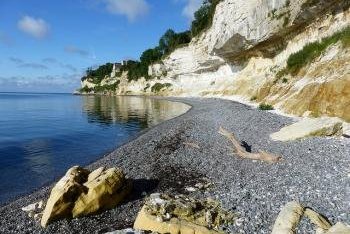
I visited this WHS in July 2016. I'd recommend downloading the huge informative Kalklandet app on your smart phone before visiting this site. It will help you locate the thin fish clay layer as well as identify any fossils you might find. The museum opens at 10am and apart from a few fossil examples and information boards, it is more of a local museum. The parking lot is automated so you'll still have to pay the day ticket to get out once your visit is ready. You can also pay by card so no cash or coins are needed. Knowing that bad weather was forecast in the afternoon, I decided to visit very early in the morning around 6:30-7am. This choice made all the difference as I had the whole site for myself for 3-4 hours. Firstly, I went down to the pebble beach by descending a relatively new but very steep steel staircase. Then you ascend a smaller but very old wooden staircase (which has seen better days!) and a very short trail through a patch of overgrowth full of peacock butterflies brought me to an apparent dead end and excellent lookout point (most of the pictures of previous reviews are from this viewpoint). I carefully climbed down to the beach over some loose rocks and limestone and was overjoyed to have the beach for myself. The morning sunlight is the best for photography and also very helpful to be able to spot the fish clay layer which is a very thin greyish brown sediment between the yellowish limestone, black flint with white exterior and white chalk. The fish clay layer holds traces of an asteroid that hit Earth 65.5 million years ago. When the asteroid hit our planet, this caused an enormous explosion and whirled huge amounts of dust into the atmosphere covering the Earth and blocking all the sunlight. It is believed that during this period more than half of all the species on Earth died out, including dinosaurs. American geologist Walter Alvarez was the first to find traces from the asteroid after analysing the fish clay in Stevns Klint. This is what gives this site its OUV as the full stretch of cliffs is full of fossils which help us learn more about our past. By looking upwards from the beach you can easily see the different exposed layers. I felt more comfortable to look as closest to the sea as possible as the cliffs are caving in and it is very easy to understand why the nearby chapel collapsed in the past! The top layer of Stevns Klint has traces from the last ice age, when large glaciers moved across the country like gigantic bulldozers. The hard limestone is made of bryozoan skeletons. These organisms lived in colonies which turned into the limestone bankswhich you see at Stevns Klint. It is relatively easy to find limestone fossils especially of ancient fungi or bivalves by cracking some rocks using the hard flint stone. Be very careful not to get carried away as I did as the flint is very sharp and I ended up with my first WHI (world heritage injury)! I was so excited to have found several fossils of shells, fish skeleton fragments, fungi and a very beautiful sea urchin fossil that I felt the minor injury was totally worth it even though it could have been avoided. The fish clay layer is quite high up and you'll need a decent zoom lens to get a closer look. The flint layers originate from the dissolved skeletons of silicious sponges (there is a big fossil of one in the museum), that inhabited the seafloor. When these organisms died out, their skeletons dissolved and over time in crustacean burrows in the seafloor, forming the flint layer we see now. The bottom soft chalk layer consists of billions of microscopic shells from algae which lived when Stevns Klint was covered by the sea. After a couple of hours I walked back to the staircases only to surprise a family of otters which were feeding on their early catch of fish! They soon vanished under the rocks and I went back up next to the church. I walked for about 4km to the opposite direction of the Stevns lighthouse to be able to see other lookout points over different stretches of the cliffs. The views are not particularly different from the church balcony view so don't bother if you're pressed for time. By the time I walked back the church has opened and there were the first couple of Danish tourists visiting. Most visit the museum for free and take in the view from the church so I wouldn't expect the beach to be overcrowded unless you're very unlucky. Just in front of the church there's a new UNESCO plaque. Next, I walked to the Stevns lighthouse and then after buying the hardback of the detailed nomination file from the museum, I drove to a quarry-like place called Holtug Kridtbrud further on from the lighthouse which is the best place to find fossils. All in all, I was very satisfied with my visit and I look forward to visiting the WHS in Devon, UK in the near future.
More on
Comments
No comments yet.
